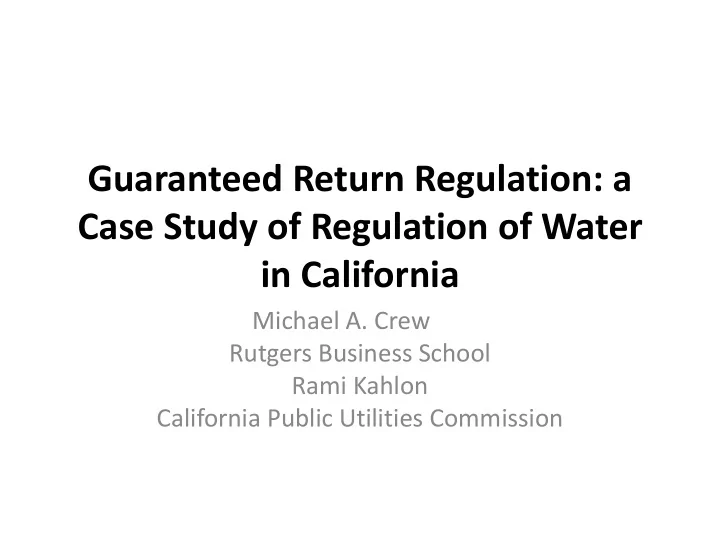

Guaranteed Return Regulation: a Case Study of Regulation of Water in California Michael A. Crew Rutgers Business School Rami Kahlon California Public Utilities Commission
Outline • 1. Motivation, Background and Introduction • 2. Regulation of Monopoly Rents • 3. Case: California Water • 4. Conclusions and Implications
Motivation • Regulation and consumers • Simple monopoly graph • Unregulated monopoly - OE • Regulation cannot provide efficiency of competition • OF’ with consumer getting all the rents at second best optimum
P E A B” F F’ B’ C’ AC B C MC MR AR 0 Q Figure 1: Monopoly Rents
Rents attract • Replication of competitive P = MC not feasible because of dominant scale economies • Second best optimality a less clear concept • Determination of Average Cost – OF’ • Regulator’s ability to estimate cost limited by asymmetric information
Dissipation of Rents • Labor and the firm • Politicians, consumers and regulators • Environmental policies • Public utility commissions (PUCs) determine the distribution of rents • Effective vehicle to enforce state environmental policies • State conservation mandates
Regulation cannot eliminate rents • Mechanism for redistribution • Opaque more effective way than taxes • Politicians oppose a tax to support environmental projects • Use utility rates • Partial immunization for legislators
Regulatory Institutions • Regulation originated in the US over a century ago • Specialist “Independent” Commissions • Cost of Service (CoS) or Rate of Return (RoR) dominant form • Process ostensibly simple – protect from monopoly exploitation and financial viability
Cos/RoR • Regulated firm typically makes its case in administrative law tribunal • RR = O + s(V-D) • O = Operating Expenses • s = Allowed Rate of Return • V = Gross value of its property (rate base) • D = Accumulated Depreciation
Asymmetric Information • Firm’s superior information on its costs • Firm’s incentive to pad costs because • RR increases as revealed costs increase • Weakness of COS in cost control -> • Price cap regulation (PCR)
• UK’s extensive privatization and adoption of PCR • Except for telecom PCR not employed significantly in the US • Took different form – Crew and Kleindorfer (1996) • Littlechild’s (1983 and 1986) influential papers • 1983 paper sees PCR is transition
What is PCR?
Definitions • CPI = Consumer Price Index or similar inflation measure • X = X factor or real price decrease • Y = Exogenous factors, e.g. taxes • T = Term of the price cap
PCR Deceptively Simple • Provides incentives for X-efficiency • But at a price • Laffont and Tirole demonstrate that efficiency • Requires commitment by regulator • Firm retaining information rents
Rents contested • PCR X-efficiency with rents to firm • CoS incentives for X-inefficiency • Consumer faces other contenders for rents • Notably government employing regulation to promote its social and environmental policies • PCR difficult to fund renewables and conservation • PCR drives the firm to maximize profits • Conservation contrary to this
PCR, CoS and rents • PCR Firm retains rents • Commission discretion reduced • Contrast cost of service regulation • With considerable discretion to regulator • But COS limited in ability to implement certain policies
Regulation to Implement Policy • E.g. conservation and increasing block rates • Policies ostensibly motivated by fairness • PCR provides little scope to implement such policies • The reverse - PCR promotes sales • CoS offers more but not sufficient scope
Evolving form of regulation • New form of regulation providing implementation possibilities • Decouple revenue requirements from output e.g. conservation and weather • Permits implementing policies through regulation • Appeals to notions of fairness – unjust enrichment
Guaranteed Return Regulation (GRR) • Energy efficiency programs • Separation of distribution and generation • Including conservation programs in CoS • Cross subsidies of renewables in CoS • Attempt to “guarantee” returns • Traditionally opportunity to earn return was guaranteed
The Guarantee in GRR • Guarantee return comes at a price • Firm faces more regulation • Loses ability to earn on increased sales in return for compensation if sales fall short • Further disincentives for X-efficiency • Lower costs normally mean greater profit not with GRR
2005 CPUC Water Action Plan • 1. Maintain Highest Standards of Water Quality • 2. Strengthen Water Conservation Programs to a • Level Comparable to those of Energy Utilities • 3. Promote Water Infrastructure Investment • 4. Assist Low Income Ratepayers • 5. Streamline CPUC Regulatory Decision-making • 6. Set Rates that Balance Investment, Conservation, and Affordability
Achieving Objectives • Less than successful but arguably unattainable under PCR • Guarantee Elusive Year Adopted Revenue Net aggregate Average WRAM Median Requirement in WRAM Under Under collection WRAM Aggregate collection Percentage Under collection Percentage 2012 $795,204,287. $53,853,477. 6.77% 8.09% 2011 $806,482,389. 56,786,925. 7.04% 8.60% 2010 $630,115,859. $37,174,377. 5.90% 5.18%
Explaining Shortfall • Incentive for DRA to over-forecast volume – a partial explanation • Recession • Weather • Despite objectives GRR limited in ability to guarantee a return • Forecasting distortions and accuracy problems
Conclusions and Implications • More accurate forecasts limited by exogenous factors and rent seeking for consumers by public advocates • Ex post adjustments for exogenous factors – weather! • Snow cap exogenous variable in rate setting • Potential future paper
Recommend
More recommend